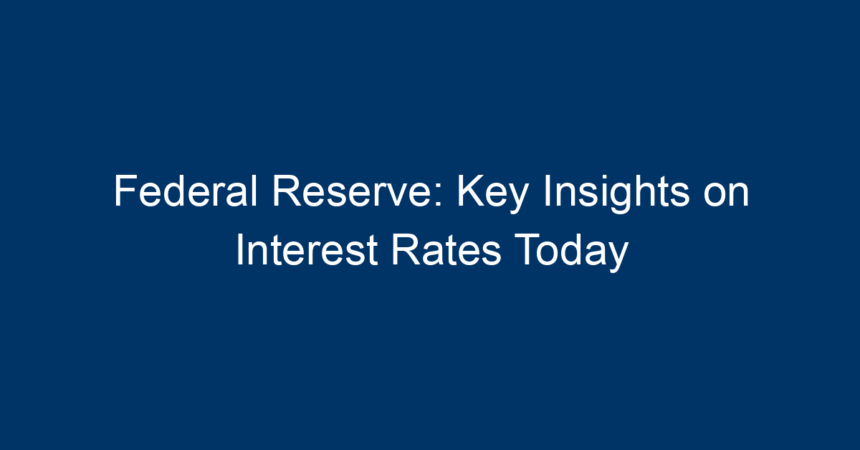The Federal Reserve plays a crucial role in shaping the economy of the United States through its management of interest rates. As the central bank, its decisions can significantly influence everything from inflation rates to the cost of borrowing, making it essential for businesses, investors, and consumers alike to stay informed. In this article, we’ll delve into the current state of interest rates as determined by the Federal Reserve, exploring their implications on the economy and offering actionable insights for navigating these changes.
Understanding the Federal Reserve’s Role
What is the Federal Reserve?
Established in 1913, the Federal Reserve, often referred to simply as the Fed, serves as the central bank of the United States. It is responsible for regulating monetary policy, ensuring financial stability, and providing banking services. Its influence extends across various sectors, affecting employment rates, inflation, and overall economic growth.
Functions of the Federal Reserve
The Federal Reserve’s primary functions include:
- Monetary Policy Implementation: Adjusting interest rates to manage economic growth and control inflation.
- Financial Stability Oversight: Monitoring banks and financial institutions to mitigate risks.
- Payment Systems: Facilitating smooth operations in the banking sector.
- Consumer Protection: Working to ensure fair treatment and transparency in banking and financial markets.
Current Interest Rates: An Overview
Recent Decisions by the Federal Reserve
As of October 2023, the Federal Reserve is maintaining a cautious approach to interest rates amid fluctuating economic indicators. Following a series of rate hikes aimed at curbing inflation, rates have stabilized at a range of 5.25% to 5.50%. This level, while elevated compared to the historical average, has become a focal point for many economists and financial analysts.
The Rationale Behind Current Rates
The Fed’s decisions on interest rates are based on extensive economic data. The current strategy is largely driven by the following factors:
- Labor Market Conditions: As unemployment rates remain low, wage growth puts additional pressure on inflation.
- Inflation Trends: Although inflation has begun to slow, it remains above the Federal Reserve’s 2% target.
- Global Economic Influences: Factors like geopolitical tensions and supply chain disruptions continue to shape the economic landscape.
The Impact of Interest Rates
On Borrowing Costs
One of the most immediate effects of interest rate changes set by the Federal Reserve is on borrowing costs. Higher interest rates mean:
- Increased Mortgage Rates: With the average mortgage rate rising alongside Fed rates, potential homebuyers face higher monthly payments.
- Business Loans: Companies seeking financing for expansion must spend more on interest, thereby affecting their growth potential.
On Consumer Behavior
Consumer spending often mirrors the cost of credit. With higher rates, individuals may:
- Deter Major Purchases: Items like cars and homes often financed through loans are likely to see reduced interest from buyers.
- Shift to Savings: As interest rates rise, individuals may find savings accounts more attractive, opting to save rather than spend.
On Investments
The Federal Reserve’s policy decisions greatly impact financial markets. When interest rates rise, investors often respond by:
- Adjusting Portfolios: Higher rates can lead to lower bond prices, prompting investors to reevaluate their asset allocations.
- Considering Alternatives: Stocks in growth sectors might underperform as borrowing costs rise, leading investors to seek safer, interest-bearing options.
Long-Term Implications of Federal Reserve Policies
Economic Growth Projections
Sustained interest rates may lead to varying projections for economic growth:
- Slowdown Fears: As borrowing costs rise, many analysts predict a deceleration in economic growth, which may prompt the Fed to rethink its strategy.
- Stagflation Risks: High inflation coupled with stagnant growth can lead to a challenging economic environment.
Preparing for Future Changes
Changes in the Federal Reserve’s interest rate policy are inevitable. Here are actionable insights for individuals and businesses:
- Monitor Economic Indicators: Keep an eye on employment rates, inflation data, and the Fed’s meeting minutes.
- Evaluate Financial Strategies: Businesses should assess how potential rate changes affect their financing needs and operational costs.
- Consider Fixed vs. Variable Rates: When borrowing, weigh the benefits of fixed-interest loans against the risks associated with variable rates.
Conclusion: Navigating the Interest Rate Landscape
Understanding the implications of Federal Reserve policies on interest rates is essential for making informed financial decisions. As the Fed maintains its current stance on rates, economic conditions will continue to evolve. Staying informed and proactive can help individuals and businesses not only weather the financial landscape but also capitalize on potential opportunities.
In summary, whether you’re a homeowner, a business owner, or an investor, the Federal Reserve’s decisions on interest rates can shape your financial future. By keeping these insights in mind, you can navigate this complex environment with greater confidence and foresight.




